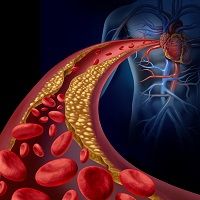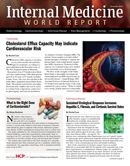Publication
Article
Internal Medicine World Report
Cholesterol Efflux Capacity May Indicate Cardiovascular Risk
Author(s):
HDL cholesterol may have atheroprotective qualities, according to a report from The New England Journal of Medicine.

Cholesterol efflux capacity is an indicator of cardiovascular risk and better target for treatments, according to a report published in the December issue of The New England Journal of Medicine.
Researchers from UT Southwestern Medical Center studied about 2,500 adult patients aged 30 to 65 years (57% female) in Dallas County, Texas, who were also enrolled in the multi-ethnic, population-based Dallas Heart Study. The patients fasted before providing blood and urine samples and were X-rayed to evaluate body composition, cardiovascular phenotyping, and body-fat distribution via magnetic resonance imaging (MRI). The patients’ blood samples were then chilled and put through a centrifuge to separate the plasma lipids, such as high-density lipoprotein (HDL) cholesterol. Cholesterol efflux capacity was evaluated using a new method used consistently across all participants.
“We drew on the strengths of the Dallas Heart Study to thoroughly investigate the relationship between HDL function and cardiovascular disease,” Anand Rohatgi, MD, Assistant Professor of Internal Medicine at UT Southwestern and the leader of the study, explained in a press release. “What we found was a strong, graded, protective relationship between cholesterol efflux and incidence of cardiovascular events among people who were free from heart disease at baseline testing.”
The HDL cholesterol level was significantly higher in women, and significantly higher in blacks than in non-blacks, as the researchers suspected. Low HDL cholesterol was present in 46% of the women and 35% of the men. No correlation was shown or was only weakly associated with traditional cardiovascular risk factors and increasing quartiles of cholesterol efflux capacity.
Primary atherosclerotic cardiovascular disease events were found in 132 of the participants during a median follow-up period of about 10 years, though after adjustment for traditional risk factors, there was not a trend of an inverse association between the adverse events and HDL cholesterol.
“HDL is very dynamic,” Rohatgi continued. “It has many functions that are not fully captured by the measurement of static cholesterol levels. The hypothesis has changed from an HDL-cholesterol hypothesis to an HDL-function hypothesis to better capture cardiovascular risk and provide a better target for therapy to reduce that risk.”
The researchers believed HDL cholesterol may have multiple atheroprotective functions because of their findings.
“Cholesterol efflux by HDL is also required for signaling by the lipoprotein in endothelial cells, which underlies the capacity of HDL to activate endothelial nitric oxide synthase and to promote endothelial repair and induce angiogenesis,” the authors wrote. “Impaired cholesterol efflux capacity has also been correlated with increased platelet reactivity in vitro.”
Traditionally, the researchers pointed out, HDL cholesterol has been viewed as good cholesterol, because of the existing literature’s association between HDL cholesterol and risk of heart disease. But that’s not always the case, Rohatgi continued.
“Unfortunately, that observation has not translated into effective therapies that target HDL cholesterol,” he said. “Niacin raises HDL cholesterol 20-25 percent and newer drugs called CETP inhibitors raise HDL cholesterol even more, but none have been shown to reduce cardiac events.”






